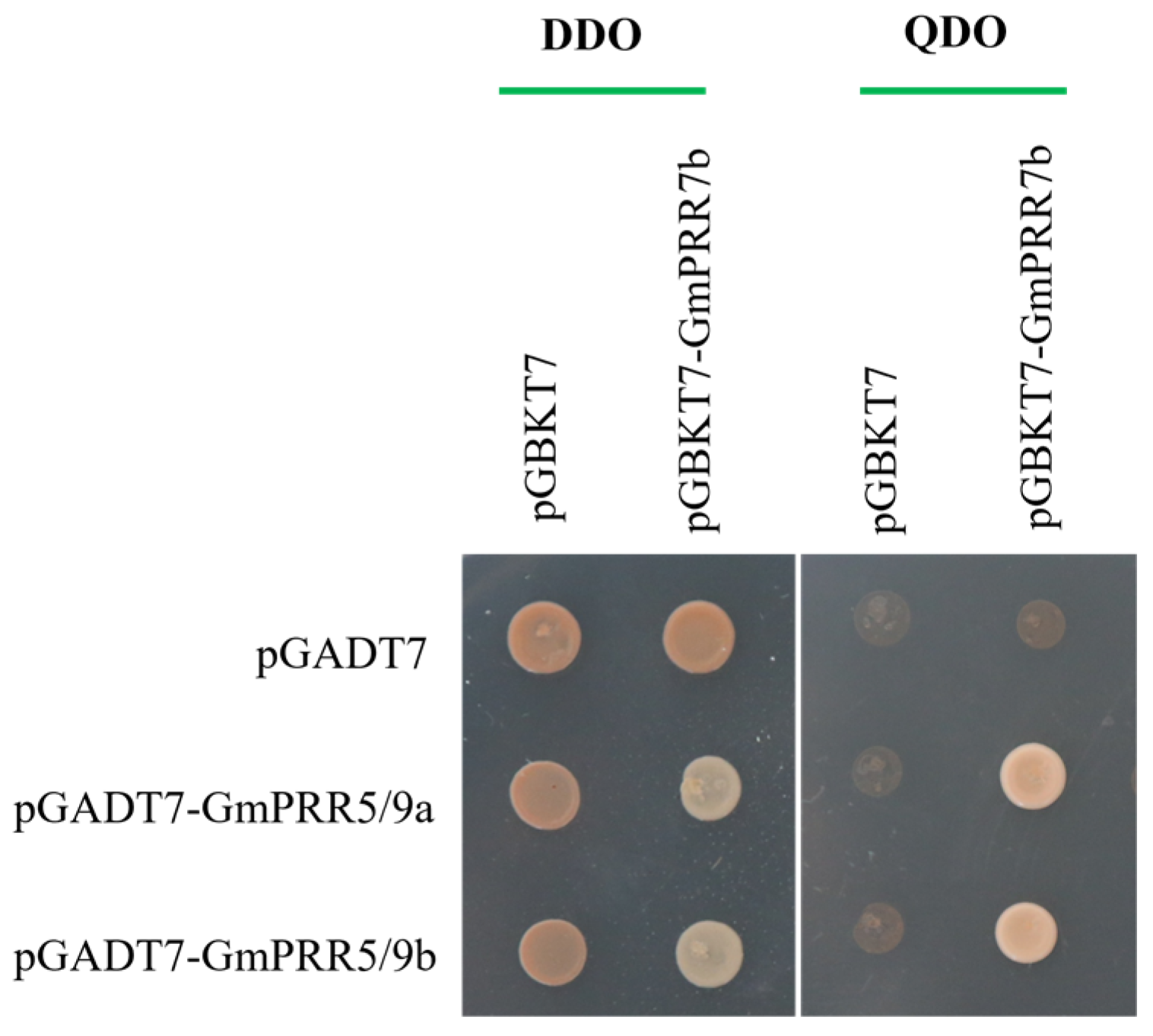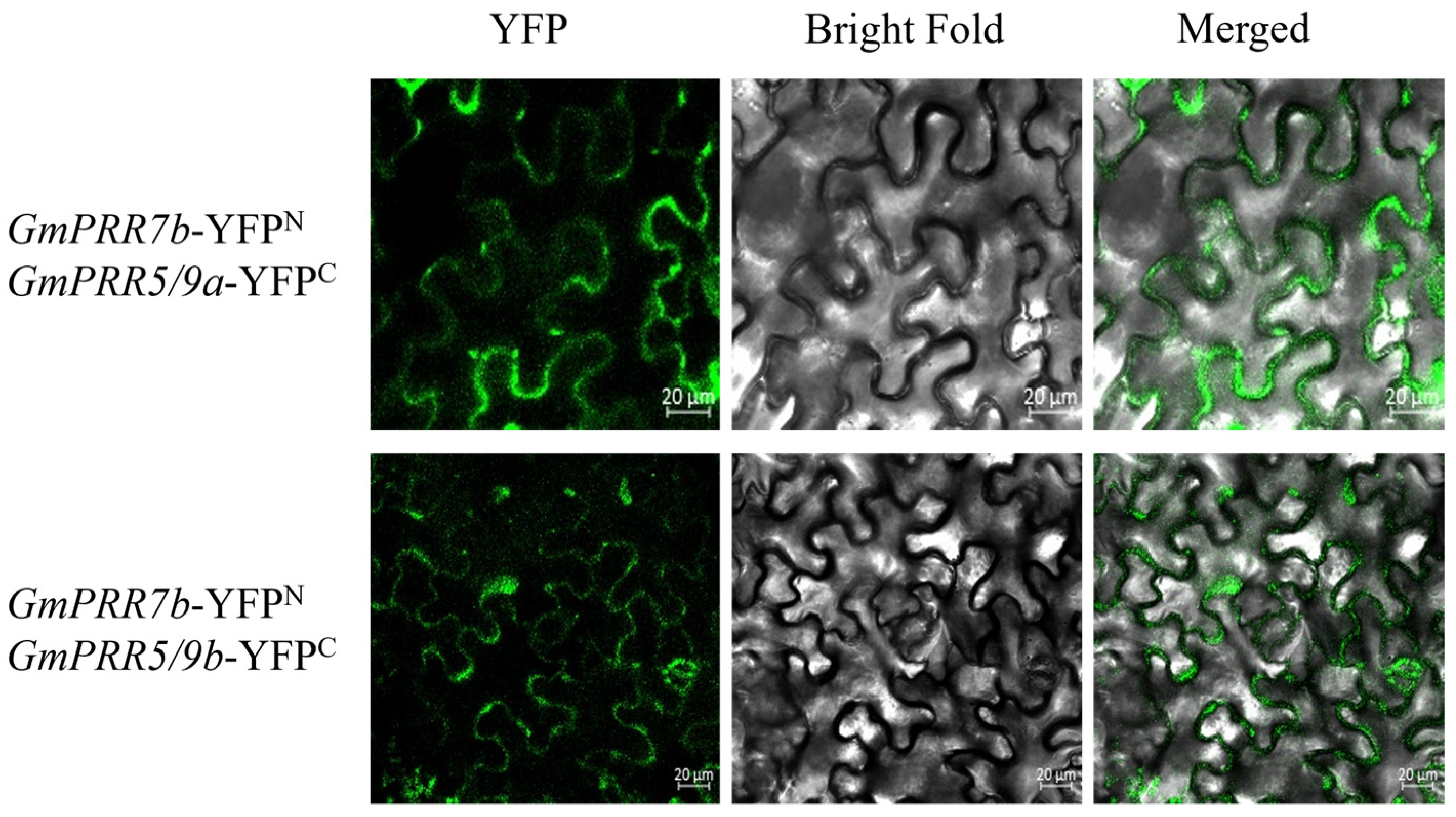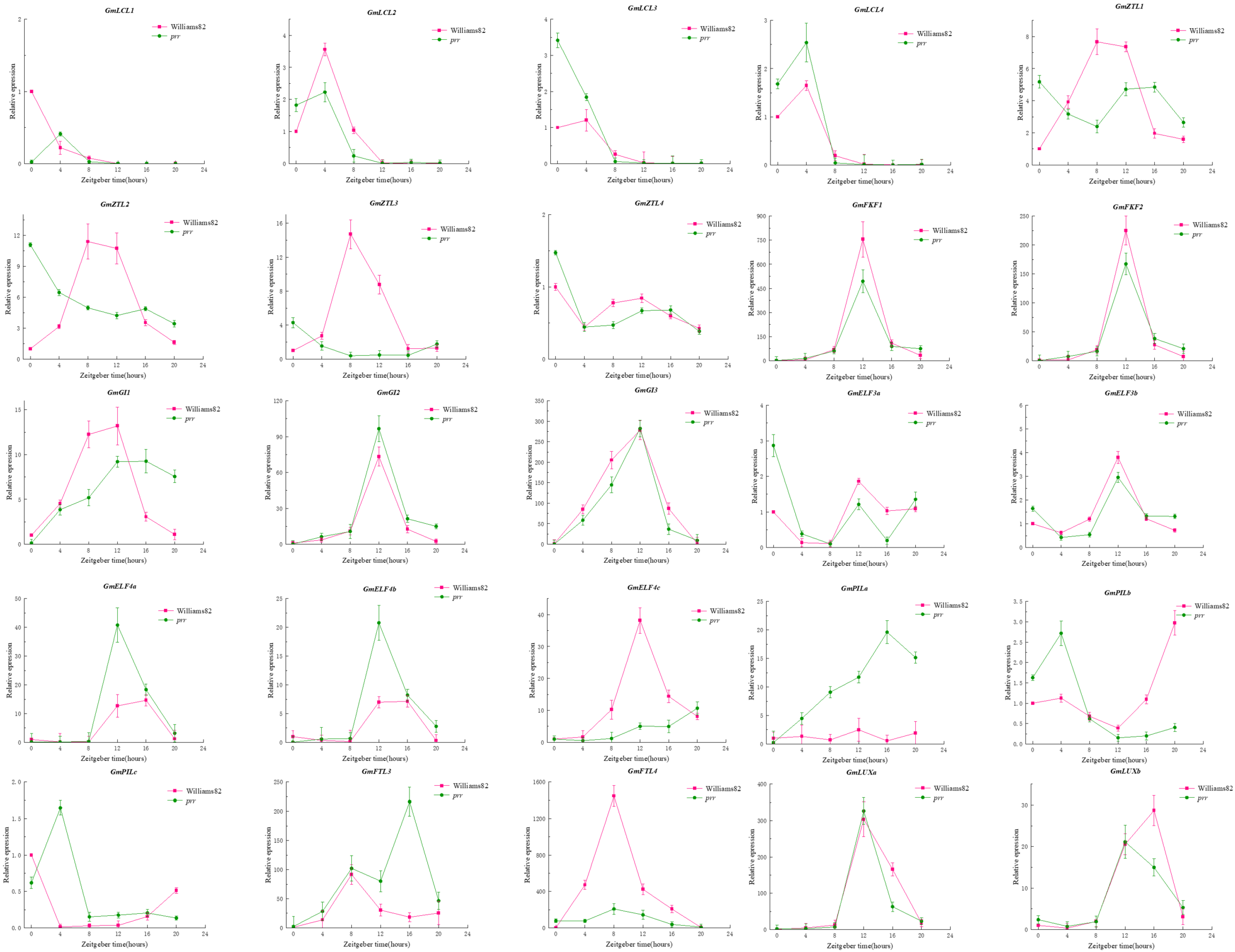Functional Verification of the Soybean Pseudo-Response Factor GmPRR7b and Regulation of Its Rhythmic Expression
Abstract
:1. Introduction
2. Results
2.1. Phenotypic Characterisation of the Glyma.12G073900
2.2. Identification and Rhythmic Expression of Gene Family Members
2.3. Verification of the Interaction Between GmPRR5/9a, GmPRR5/9b, and GmPRR7b
2.4. Gene Regulatory Network Prediction
3. Discussion
4. Materials and Methods
4.1. Preparation of Plant Material
4.2. Identification of Gene Family Members
4.3. Rhythmic Expression of Members
4.4. RNA Isolation and Quantitative Real-Time PCR Analysis
4.5. Validation of Gene Regulatory Networks
4.6. Subcellular Localization and Experimental Validation of Interacting Proteins
Supplementary Materials
Author Contributions
Funding
Institutional Review Board Statement
Informed Consent Statement
Data Availability Statement
Conflicts of Interest
References
- Harmer, S.L. The Circadian System in Higher Plants. Annu. Rev. Plant Biol. 2009, 60, 357–377. [Google Scholar] [CrossRef] [PubMed]
- Farré, E.M.; Liu, T. The PRR family of transcriptional regulators reflects the complexity and evolution of plant circadian clocks. Curr. Opin. Plant Biol. 2013, 16, 621–629. [Google Scholar] [CrossRef]
- Mcclung, C.R. Circadian Clock Components Offer Targets for Crop Domestication and Improvemen. Genes 2021, 12, 374. [Google Scholar] [CrossRef] [PubMed]
- Bunning, E. Endogenous Rhythms in Plants. Annu. Rev. Plant Physiol. 2003, 7, 71–90. [Google Scholar] [CrossRef]
- Bunning, E. Circadian Leaf Movements in Bean Plants: Earlier Reports. Science 1964, 146, 551. [Google Scholar] [CrossRef]
- Xu, X.; Yuan, L.; Yang, X.; Zhang, X.; Wang, L.; Xie, Q. Circadian clock in plants: Linking timing to fitness. J. Integr. Plant Biol. 2022, 64, 792–811. [Google Scholar] [CrossRef] [PubMed]
- Park, M.J.; Sec, P.J.; Park, C.M. CCA1 alternative splicing as a way of linking the circadian clock to temperature response in Arabidopsis. Plant Signal. Behav. 2012, 7, 1194–1196. [Google Scholar] [CrossRef]
- Mizuno, T.; Nakamichi, N. Pseudo-Response Regulators (PRRs) or true oscillator components (TOCs). Plant Cell Physiol. 2005, 46, 677–685. [Google Scholar] [CrossRef]
- Millar, A.; Carre, I.; Strayer, C.; Chua, N.; Kay, S. Circadian clock mutants in Arabidopsis identified by luciferase imaging. Science 1995, 267, 1161–1163. [Google Scholar] [CrossRef]
- Alabadi, D. Reciprocal Regulation Between TOC1 and LHY/CCA1 Within the Arabidopsis Circadian Clock. Science 2001, 293, 880–883. [Google Scholar] [CrossRef]
- Para, A.; Farre, E.M.; Imaizumi, T.; Pruneda-Paz, J.L.; Harmon, F.G.; Kay, S.A. PRR3 Is a vascular regulator of TOC1 stability in the Arabidopsis circadian clock. Plant Cell 2007, 19, 3462–3473. [Google Scholar] [CrossRef] [PubMed]
- Nakamichi, N.; Kita, M.; Ito, S.; Sato, E.; Yamashino, T.; Mizuno, T. The Arabidopsis pseudo-response regulators, PRR5 and PRR7, coordinately play essential roles for circadian clock function. Plant Cell Physiol. 2005, 46, 609–619. [Google Scholar] [CrossRef] [PubMed]
- Farre, E.M.; Harmer, S.L.; Harmon, F.G.; Yanovsky, M.J.; Kay, S.A. Overlapping and distinct roles of PRR7 and PRR9 in the Arabidopsis circadian clock. Curr. Biol. 2005, 15, 47–54. [Google Scholar] [CrossRef]
- Matsushika, A.; Makino, S.; Kojima, M.; Mizuno, T. Circadian waves of expression of the APRR1/TOC1 family of pseudo-response regulators in Arabidopsis thaliana: Insight into the plant circadian clock. Plant Cell Physiol. 2000, 41, 1002–1012. [Google Scholar] [CrossRef] [PubMed]
- Fukushima, A.; Kusano, M.; Nakamichi, N.; Kobayashi, M.; Hayashi, N.; Sakakibara, H.; Mizuno, T.; Saito, K. Impact of clock-associated Arabidopsis pseudo-response regulators in metabolic coordination. Proc. Natl. Acad. Sci. USA 2009, 106, 7251–7256. [Google Scholar] [CrossRef]
- Nakamichi, N.; Kita, M.; Niinuma, K.; Ito, S.; Yamashino, T.; Mizoguchi, T.; Mizuno, T. Arabidopsis Clock-Associated Pseudo-Response Regulators PRR9, PRR7 and PRR5 Coordinately and Positively Regulate Flowering Time Through the Canonical CONSTANS-Dependent Photoperiodic Pathway. Plant Cell Physiol. 2007, 48, 822. [Google Scholar] [CrossRef]
- Liu, T.; Carlsson, J.; Takeuchi, T.; Newton, L.; Farre, E.M. Direct regulation of abiotic responses by the Arabidopsis circadian clock component PRR7. Plant J. 2013, 76, 101–114. [Google Scholar] [CrossRef]
- Nakamichi, N. Transcript Profiling of an Arabidopsis PSEUDO RESPONSE REGULATOR Arrhythmic Triple Mutant Reveals a Role for the Circadian Clock in Cold Stress Response. Plant Cell Physiol. 2009, 50, 447–462. [Google Scholar] [CrossRef]
- Nusinow, D.A.; Helfer, A.; Hamilton, E.E.; King, J.J.; Imaizumi, T.; Schultz, T.F.; Farre, E.M.; Kay, S.A. The ELF4-ELF3-LUX complex links the circadian clock to diurnal control of hypocotyl growth. Nature 2012, 475, 398–402. [Google Scholar] [CrossRef]
- Mizoguchi, T.; Wright, L.; Fujiwara, S.; Cremer, F.; Lee, K.; Onouchi, H.; Mouradov, A.; Fowler, S.; Kamada, H.; Coupland, P.G. Distinct Roles of GIGANTEA in Promoting Flowering and Regulating Circadian Rhythms in Arabidopsis. Plant Cell 2005, 17, 2255–2270. [Google Scholar] [CrossRef]
- Blázquez, M.A. Flower Development Pathways. J. Cell Sci. 2000, 113, 3547–3548. [Google Scholar] [CrossRef] [PubMed]
- Hou, Z.H.; Liu, B.H.; Kong, F.J. Regulation of Flowering and Maturation in Soybean. Adv. Bot. Res. 2022, 102, 43–75. [Google Scholar]
- Murakami, M.; Matsushika, A.; Ashikari, M.; Yamashino, T.; Mizuno, T. Circadian-associated rice pseudo response regulators (OsPRRs): Insight into the control of flowering time. Biosci. Biotechnol. Biochem. 2005, 69, 410–414. [Google Scholar] [CrossRef]
- Sun, C.; Chen, D.; Fang, J.; Wang, P.; Deng, X.; Chu, C. Understanding the genetic and epigenetic architecture in complex network of rice flowering pathways. Protein Cell 2014, 5, 889–898. [Google Scholar] [CrossRef]
- Zhang, B.; Liu, H.; Qi, F.; Zhang, Z.; Xing, Y. Genetic Interactions Among Ghd7, Ghd8, OsPRR37 and Hd1 Contribute to Large Variation in Heading Date in Rice. Rice 2019, 12, 48. [Google Scholar] [CrossRef] [PubMed]
- Koo, B.H.; Yoo, S.C.; Park, J.W.; Kwon, C.T.; Lee, B.D.; An, G.; Zhang, Z. Natural Variation in OsPRR37 Regulates Heading Date and Contributes to Rice Cultivation at a Wide Range of Latitudes. Mol. Plant 2013, 6, 1877–1888. [Google Scholar] [CrossRef]
- Nakamichi, N.; Kudo, T.; Makita, N.; Kiba, T.; Sakakibara, H. Flowering time control in rice by introducing Arabidopsis clock-associated PSEUDO-RESPONSE REGULATOR 5. Biosci. Biotechnol. Biochem. 2020, 84, 970–979. [Google Scholar] [CrossRef]
- Irum, S.; Rehman, N.; Inam, S.; Khan, M.Z.F.; Khan, M.R. Genome-wide identification and expression profiling of Pseudo-Response Regulator (PRR) gene family in tomato. Environ. Exp. Bot. 2024, 220, 105683. [Google Scholar] [CrossRef]
- Liu, Z.; Liu, W.; Wang, Z.; Xie, Z.; Qi, K.; Yue, D.; Li, Y.; Zhang, S.; Wu, J.; Wang, P. Molecular characterization of PSEUDO RESPONSE REGULATOR family in Rosaceae and function of PbPRR59a and PbPRR59b in flowering regulation. BMC Genom. 2024, 25, 794. [Google Scholar] [CrossRef]
- Wang, J.; Du, Z.; Huo, X.; Zhou, J.; Chen, Y.; Zhang, J.; Pan, A.; Wang, X.; Wang, F.; Zhang, J. Genome-wide analysis of PRR gene family uncovers their roles in circadian rhythmic changes and response to drought stress in Gossypium hirsutum L. PeerJ 2020, 8, e9936. [Google Scholar] [CrossRef]
- Zhang, S.R.; Wang, H.; Wang, Z.Y.; Ren, Y.; Niu, L.F. Photoperiodism dynamics during the domestication and improvement of soybea. Sci. China Life Sci. 2017, 60, 1416–1427. [Google Scholar] [CrossRef] [PubMed]
- Li, M.W.; Liu, W.; Lam, H.M.; Gendron, J.M. Characterization of Two Growth Period QTLs Reveals Modification of PRR3 Genes during Soybean Domestication. Plant Cell Physiol. 2018, 60, 407–420. [Google Scholar] [CrossRef]
- Li, Y.; Dong, Y.; Wu, H.; Hu, B.; Xia, Z. Positional Cloning of the Flowering Time QTL qFT12-1 Reveals the Link Between the Clock Related PRR Homolog With Photoperiodic Response in Soybeans. Front. Plant Sci. 2019, 10, 1303. [Google Scholar] [CrossRef]
- Wang, L.W.; Sun, S.; Wu, T.T. Natural variation and CRISPR/Cas9-mediated mutation in GmPRR37 affect photoperiodic flowering and contribute to regional adaptation of soybean. Plant Biotechnol. J. 2020, 18, 1869–1881. [Google Scholar] [CrossRef]
- Li, C.; Li, Y.H.; Li, Y.; Lu, H.; Qiu, L.J. A Domestication-Associated Gene GmPRR3b Regulates Circadian Clock and Flowering Time in Soybean. Mol. Plant 2020, 13, 745–759. [Google Scholar] [CrossRef]
- Lu, S.J.; Dong, L.D.; Fang, C.; Liu, S.L.; Kong, L.P.; Cheng, Q.; Chen, L.Y.; Su, T.; Nan, H.Y.; Zhang, D.; et al. Stepwise selection on homeologous PRR genes controlling flowering and maturity during soybean domestication. Nat. Genet. 2020, 52, 428–436. [Google Scholar] [CrossRef] [PubMed]
- Wang, P.G.; Wang, L.W.; Zhang, L.X.; Wu, T.T.; Sun, B.Q.; Zhang, J.Q.; Sapey, E.; Yuan, S.; Jiang, B.J.; Chen, F.L.; et al. Genomic Dissection and Diurnal Expression Analysis Reveal the Essential Roles of the PRR Gene Family in Geographical Adaptation of Soybean. Int. J. Mol. Sci. 2022, 23, 9970. [Google Scholar] [CrossRef] [PubMed]
- Dong, L.; Fang, C.; Cheng, Q.; Su, T.; Liu, B. Genetic Basis and Adaptation Trajectory of Soybean from Its Temperate Origin to Tropics. Nat. Commun. 2021, 12, 5445. [Google Scholar] [CrossRef]
- Qin, C.; Li, H.Y.; Zhang, S.R.; Lin, X.Y.; Jia, Z.W.; Zhao, F.; Wei, X.Z.; Jiao, Y.C.; Li, Z.; Niu, Z.Y.; et al. GmEID1 modulates light signaling through the Evening Complex to control flowering time and yield in soybean. Proc. Natl. Acad. Sci. USA 2023, 120, e2212468120. [Google Scholar] [CrossRef]
- Makino, S.; Kiba, T.; Imamura, A.; Hanaki, N.; Nakamura, A.; Suzuki, T.; Taniguchi, M.; Ueguchi, C. Genes Encoding Pseudo-Response Regulators: Insight into His-to-Asp Phosphorelay and Circadian Rhythm in Arabidopsis thalian. Plant Cell Physiol. 2000, 41, 791–803. [Google Scholar] [CrossRef]
- Zhao, S.L.; Jing, Y.F.; Liu, Q.Q.; Yang, M.; Wang, C.L. The role of the pseudo-response regulator protein in the plant photoperiodic regulatory pathway. J. Nucl. Agric. 2018, 32, 1740–1749. [Google Scholar]
- Imamura, A.; Hanaki, N.; Nakamura, A.; Suzuki, T.; Taniguchi, M.; Kiba, T.; Ueguchi, C.; Sugiyama, T.; Mizuno, T. Compilation and Characterization of Arabiopsis thaliana Response Regulators Implicated in His-Asp Phosphorelay Signal Transduction. Plant Cell Physiol. 1999, 40, 733–742. [Google Scholar] [CrossRef]
- Hwang, I.; Chen, H.C.; Sheen, J. Two-Component Signal Transduction Pathways in Arabidopsis. Plant Physiol. 2002, 129, 500–515. [Google Scholar] [CrossRef] [PubMed]
- Imaizumi, T. Arabidopsis Circadian Clock and Photoperiodism: Time to Think about Locatio. Curr. Opin. Plant Biol. 2010, 13, 83–89. [Google Scholar] [CrossRef]
- Pruneda-Paz, J.L.; Kay, S.A. An Expanding Universe of Circadian Networks in Higher Plants. Trends Plant Sci. 2010, 15, 259–265. [Google Scholar] [CrossRef]
- Wang, Y.; Yuan, L.; Su, T.; Wang, Q.; Gao, Y.; Zhang, S.Y.; Jia, Q.; Yu, G.L.; Fu, Y.F.; Cheng, Q.; et al. Light- and temperature-entrainable circadian clock in soybean development. Plant Cell Environ. 2020, 43, 637–648. [Google Scholar] [CrossRef]
- Wu, Z.J. Gene Cloning, Expression Pattern and Function Analysis of GmTOC1s and GmLCLs in Soybean. Ph.D. Thesis, Inner Mongolia Agricultural University, Hohhot, China, 2010. [Google Scholar]
- Wang, F.; Liu, S.R.; Li, H.Y.; Fang, C.; Fang, S.J.; Wang, J.H.; Li, S.C.; Liu, H.; Du, H.P.; Wang, L.S.; et al. Artificial selection of two antagonistic e3 ubiquitin ligases finetunes soybean photoperiod adaptation and grain yield. Proc. Natl. Acad. Sci. USA 2024, 121, e2321473121. [Google Scholar] [CrossRef] [PubMed]
- Li, F.; Zhang, X.; Hu, R.; Wu, F.; Fu, Y. Identification and molecular characterization of fkf1 and gi homologous genes in soybean. PLoS ONE 2013, 8, e79036. [Google Scholar] [CrossRef]
- Zhao, X.; Li, H.; Wang, L.; Wang, J.; Huang, Z.; Du, H.; Li, Y.; Yang, J.; He, M.; Cheng, Q. A critical suppression feedback loop determines soybean photoperiod sensitivity. Dev. Cell 2024, 59, 19. [Google Scholar] [CrossRef]
- Liang, Y.M.; Tian, F. E2 family and evening complex identify soybean photoperiod sensitivity. New Crops 2025, 2949–9526. [Google Scholar] [CrossRef]
- Guo, D.Q.; Yang, X.D.; Bao, S.J.; Guo, S.D.; Kang, L.S.; Yi, A.P.; Qian, X.Y.; Zhao, G.L. Obtaining and stably expressing soybean with double-price insect-resistant genes of CryIA and CpTI. Chin. Agric. Sci. 2008, 10, 2957–2962. [Google Scholar]
- Zhu, S.; Chen, M.; Liang, C. Characterization of purple acid phosphatase family and functional analysis of GmPAP7a/7b involved in extracellular ATP utilization in soybean. Front. Plant Sci. 2020, 11, 661. [Google Scholar] [CrossRef] [PubMed]
- He, H.B. Functional Analysis of the Soybean MADS-Box Family GmAP3 Gene in Flower Development. Master’s Thesis, Jilin Agricultural University, Changchun, China, 2023; pp. 43–44. [Google Scholar]
- Dong, H.X. Research on the Interaction Between GmNaKR1 and the Soybean Flowering Promoter Gene GmFT2. Master’s Thesis, Harbin Normal University, Harbin, China, 2024; pp. 36–37. [Google Scholar]






Disclaimer/Publisher’s Note: The statements, opinions and data contained in all publications are solely those of the individual author(s) and contributor(s) and not of MDPI and/or the editor(s). MDPI and/or the editor(s) disclaim responsibility for any injury to people or property resulting from any ideas, methods, instructions or products referred to in the content. |
© 2025 by the authors. Licensee MDPI, Basel, Switzerland. This article is an open access article distributed under the terms and conditions of the Creative Commons Attribution (CC BY) license (https://creativecommons.org/licenses/by/4.0/).
Share and Cite
Song, Z.; Liu, J.; Qian, X.; Xia, Z.; Wang, B.; Liu, N.; Yi, Z.; Li, Z.; Dong, Z.; Zhang, C.; et al. Functional Verification of the Soybean Pseudo-Response Factor GmPRR7b and Regulation of Its Rhythmic Expression. Int. J. Mol. Sci. 2025, 26, 2446. https://doi.org/10.3390/ijms26062446
Song Z, Liu J, Qian X, Xia Z, Wang B, Liu N, Yi Z, Li Z, Dong Z, Zhang C, et al. Functional Verification of the Soybean Pseudo-Response Factor GmPRR7b and Regulation of Its Rhythmic Expression. International Journal of Molecular Sciences. 2025; 26(6):2446. https://doi.org/10.3390/ijms26062446
Chicago/Turabian StyleSong, Ziye, Jia Liu, Xueyan Qian, Zhengjun Xia, Bo Wang, Nianxi Liu, Zhigang Yi, Zhi Li, Zhimin Dong, Chunbao Zhang, and et al. 2025. "Functional Verification of the Soybean Pseudo-Response Factor GmPRR7b and Regulation of Its Rhythmic Expression" International Journal of Molecular Sciences 26, no. 6: 2446. https://doi.org/10.3390/ijms26062446
APA StyleSong, Z., Liu, J., Qian, X., Xia, Z., Wang, B., Liu, N., Yi, Z., Li, Z., Dong, Z., Zhang, C., Zhang, B., Tadege, M., Dong, Y., & Li, Y. (2025). Functional Verification of the Soybean Pseudo-Response Factor GmPRR7b and Regulation of Its Rhythmic Expression. International Journal of Molecular Sciences, 26(6), 2446. https://doi.org/10.3390/ijms26062446







